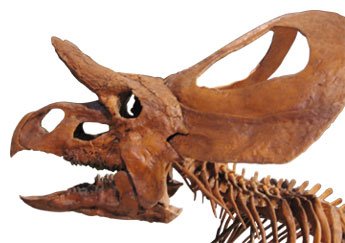Introduction to the Ceratopsians
 Zuniceratops skull. Photo © Geb Bennett. |
Imagine a snorting, stampeding, five-ton animal the size of a car, with a giant bony frill on its head, and you've got a fairly accurate picture of a ceratopsian dinosaur such as Triceratops. Ceratopsians were ornithischians, or "bird-hipped" dinosaurs. The oldest ceratopsians appeared at the beginning of the Cretaceous, about 140 million years ago. In the Late Cretaceous, about 100 million years ago, the ceratopsians began to diversify in North America and in Asia. Forms without the enormous horns and frills of Triceratops, in the family Protoceratopsidae, include the Mongolian genus Protoceratops and the unusual bipedal, frill-less dinosaur Psittacosaurus ("parrot-lizard"). The horned, frilled dinosaurs in the family Ceratopsidae are found only in the Late Cretaceous of North America; they are among the last of the dinosaurs (other than the birds of course).
 Artist's reconstruction of Triceratops. |
How did ceratopsians live? Their "beak" and rows of grinding cheek teeth suggest that they fed on tough vegetation. The huge, heavy "frill" of ceratopsians such as Triceratops may have served as armor against the attacks of saurischian predators like Tyrannosaurus, which lived in the same time and place as Triceratops. However, other ceratopsians had smaller frills and/or frills with large openings; such frills would have been little defense against a predator. So ceratopsian frills may also have functioned as heat radiators, or signaling devices, or to attract mates, in addition to whatever protective function they may or may not have had. Recent work on the oxygen isotopes found inside the bony frill, which indicate the relative temperatures of different parts of the bone, supports the first of these hypotheses: the frills functioned as heat radiators.
Ceratopsians probably traveled in herds; there are "bone beds" in the western United States that contain the bones of hundreds of individuals of the same species of ceratopsian. If attacked, the herd could stampede, or "circle the wagons" and fend off predators. In terms of animals living today, it may be best to think of ceratopsians — at least the larger ones — as analogues of elephants or rhinos: large herbivores in herds that relied on horns and attitude to protect themselves.
The Ceratopsians and pachycephalosaurs ("bone-heads") together make up the Marginocephalia.
Source:
- Carroll, R.L. 1988. Vertebrate Paleontology and Evolution. W.H. Freeman and Company, New York.